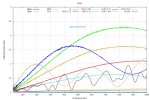Hillbilly Heaven
Explorer
Bill excellent antenna. Can take some serious tree limb banging Having no open coil in the whip, no worries about catching a limb and pulling the whip out or worse do body damage.
Excellent point about the RG8X. Never tried to solder 8X to an NM0 mount, but I guess it just takes patience. If you are going to go to the trouble of making your own cable I would suggest LMR240UF. It is the same diameter as 8X, just as flexible with stranded center conductor, and has 3db less loss. Davis RF or RF Parts both carry it.
Excellent point about the RG8X. Never tried to solder 8X to an NM0 mount, but I guess it just takes patience. If you are going to go to the trouble of making your own cable I would suggest LMR240UF. It is the same diameter as 8X, just as flexible with stranded center conductor, and has 3db less loss. Davis RF or RF Parts both carry it.

